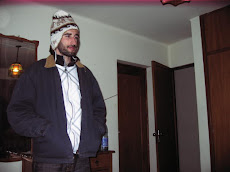
SAN PEDRO DE ATACAMA, Chile - Only an hour before Meghan and I had planned a crazy hour-and-half bus ride to a bigger pueblo just to use a working ATM, a technician fixed the one Visa ATM in this desert town. For the first time in nearly five days we have cash, in this case Chilean pesos. We immediately walked to the swanky hotel of the American couple who had lent us money on our tour of the desert salt flats and paid them back in pesos with a grateful handshake.
Despite the money troubles, our three-day tour of the Salar de Uyuni, the world´s largest salt lake desert, and the humongous Reserva de Fauna Andina Eduardo Avaroa, an absolutely stunning wildlife reserve straddling the Bolivan-Chilean border, was definitely one of the highlights of our journey. During the day we rode over in a four-wheel drive, walked on and generally admired the salt flats, which gleamed in the sunlight for miles in every direction, with small islands of land barely visible in the distance. From afar it looks like you are walking or driving on ice or snow, but this inhospitable environment is made entirely of salt. One taste confirms it. The first night, we bunked in a hotel built entirely of salt just off the desert floor. The Salar de Uyuni received a number of votes a few years ago as one of the wonders of the modern world. I can see why. Despite the rustic nature of the tour, the LandCruiser came equipped with a plug for an iPod -- which we appreciated even more once it turned out the driver had brought only a few CDs of Spanish techno and 1970s disco hits
Reserva de Fauna Andina Eduardo Avaroa has just about everything you could want in a natural park. Towering peaks, ice covered rivers, giant mountain outcroppings, sand covered desert, and glacial salt lakes with algae that cause the water at times to turn green and red, making it a perfect habitat for all three species of flamingo. Seeing flamingos wading in multi-colored lakes is like looking through neon glasses. We stayed that night in the block lodges near the main lake. This was very basic stuff, no heat, no protection from the elements but a block wall and a sleeping bag. When I woke up at 5 a.m. the next morning to visit the natural volcanic steam geysers my alarm clock registered the temperature as 34.7 F. Only later, did we realize we slumbered in this harsh but beautiful place on Noche de San Juan, the coldest night of the year.
Despite the money troubles, our three-day tour of the Salar de Uyuni, the world´s largest salt lake desert, and the humongous Reserva de Fauna Andina Eduardo Avaroa, an absolutely stunning wildlife reserve straddling the Bolivan-Chilean border, was definitely one of the highlights of our journey. During the day we rode over in a four-wheel drive, walked on and generally admired the salt flats, which gleamed in the sunlight for miles in every direction, with small islands of land barely visible in the distance. From afar it looks like you are walking or driving on ice or snow, but this inhospitable environment is made entirely of salt. One taste confirms it. The first night, we bunked in a hotel built entirely of salt just off the desert floor. The Salar de Uyuni received a number of votes a few years ago as one of the wonders of the modern world. I can see why. Despite the rustic nature of the tour, the LandCruiser came equipped with a plug for an iPod -- which we appreciated even more once it turned out the driver had brought only a few CDs of Spanish techno and 1970s disco hits
Reserva de Fauna Andina Eduardo Avaroa has just about everything you could want in a natural park. Towering peaks, ice covered rivers, giant mountain outcroppings, sand covered desert, and glacial salt lakes with algae that cause the water at times to turn green and red, making it a perfect habitat for all three species of flamingo. Seeing flamingos wading in multi-colored lakes is like looking through neon glasses. We stayed that night in the block lodges near the main lake. This was very basic stuff, no heat, no protection from the elements but a block wall and a sleeping bag. When I woke up at 5 a.m. the next morning to visit the natural volcanic steam geysers my alarm clock registered the temperature as 34.7 F. Only later, did we realize we slumbered in this harsh but beautiful place on Noche de San Juan, the coldest night of the year.





3 comments:
I enjoy your blog very much and at times envy the adventure you're having.
BTW, axe fell at the Post today, buyouts offered and I'm gone Aug. 12. They won't let me go before that. JIM Reeder
A natural wonder.
It's the type of place you think you're on some other planet... some planet where apes will ride in on horseback over the ridge!
marc
Wow you guys! This is truly a great adventure! It's so cool that you got to see another country. The Salt Flat pictures are so beautiful! Please stay warm and safe!
Love,
Kerry
Post a Comment